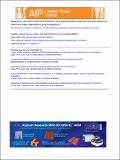| dc.contributor.author | It Wong, Jen | |
| dc.contributor.author | Wang, Lu | |
| dc.contributor.author | Shi, Yumeng | |
| dc.contributor.author | Palacios, Tomas | |
| dc.contributor.author | Kong, Jing | |
| dc.contributor.author | Dong, Xiaochen | |
| dc.contributor.author | Ying Yang, Hui | |
| dc.date.accessioned | 2014-05-28T15:25:59Z | |
| dc.date.available | 2014-05-28T15:25:59Z | |
| dc.date.issued | 2014-02 | |
| dc.date.submitted | 2013-12 | |
| dc.identifier.issn | 0003-6951 | |
| dc.identifier.issn | 1077-3118 | |
| dc.identifier.uri | http://hdl.handle.net/1721.1/87553 | |
| dc.description.abstract | Cryptosporidium parvum is a common intestinal parasitic protozoan that causes gastroenteritis in man and animals. It poses high risks to drinking water supply because of its ubiquitous distribution in water and their oocysts are resistant to harsh environment conditions. In this work, we demonstrated the use of large-size chemical vapor deposition (CVD) grown graphene films configured as field-effect device for rapid electrical detection of Cryptosporidium parvum oocysts (Cp. oocysts). The presence of Cp. oocysts causes the change in the transport characteristics of the antibody-functionalized graphene device, which can be measured in terms of the dependence of the drain current on the sweep of the gate voltage or the real-time drain current data under a constant gate voltage. The high sensor sensitivity of 25 oocysts per milliliter solution and good specificity were evaluated, indicating it a promising candidate for detecting waterborne pathogens in water quality control. | en_US |
| dc.description.sponsorship | Singapore University of Technology and Design (Zhe Jiang University joint pilot research project (SUTD-ZJU/PILOT/01/2011)) | en_US |
| dc.description.sponsorship | Jiangsu Province (China) (Funds for Distinguished Young Scholars (SBK201310284)) | en_US |
| dc.description.sponsorship | National Natural Science Foundation (China) (1275076) | en_US |
| dc.description.sponsorship | National Natural Science Foundation (China) (61328401) | en_US |
| dc.description.sponsorship | China. Ministry of Education (212058) | en_US |
| dc.description.sponsorship | Specialized Research Fund for the Doctoral Program of Higher Education (China) (20123223110008) | en_US |
| dc.language.iso | en_US | |
| dc.publisher | American Institute of Physics | en_US |
| dc.relation.isversionof | http://dx.doi.org/10.1063/1.4864154 | en_US |
| dc.rights | Article is made available in accordance with the publisher's policy and may be subject to US copyright law. Please refer to the publisher's site for terms of use. | en_US |
| dc.source | MIT web domain | en_US |
| dc.title | Real-time, sensitive electrical detection of Cryptosporidium parvum oocysts based on chemical vapor deposition-grown graphene | en_US |
| dc.type | Article | en_US |
| dc.identifier.citation | It Wong, Jen, Lu Wang, Yumeng Shi, Tomás Palacios, Jing Kong, Xiaochen Dong, and Hui Ying Yang. “Real-Time, Sensitive Electrical Detection of Cryptosporidium Parvum Oocysts Based on Chemical Vapor Deposition-Grown Graphene.” Appl. Phys. Lett. 104, no. 6 (February 10, 2014): 063705. © 2014 AIP Publishing. | en_US |
| dc.contributor.department | Massachusetts Institute of Technology. Department of Electrical Engineering and Computer Science | en_US |
| dc.contributor.mitauthor | Palacios, Tomas | en_US |
| dc.contributor.mitauthor | Kong, Jing | en_US |
| dc.relation.journal | Applied Physics Letters | en_US |
| dc.eprint.version | Final published version | en_US |
| dc.type.uri | http://purl.org/eprint/type/JournalArticle | en_US |
| eprint.status | http://purl.org/eprint/status/PeerReviewed | en_US |
| dspace.orderedauthors | It Wong, Jen; Wang, Lu; Shi, Yumeng; Palacios, Tomás; Kong, Jing; Dong, Xiaochen; Ying Yang, Hui | en_US |
| dc.identifier.orcid | https://orcid.org/0000-0003-0551-1208 | |
| dc.identifier.orcid | https://orcid.org/0000-0002-2190-563X | |
| mit.license | PUBLISHER_POLICY | en_US |
| mit.metadata.status | Complete | |
